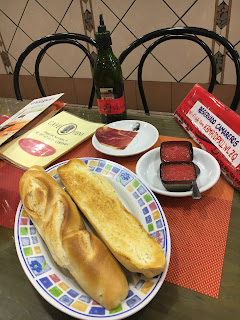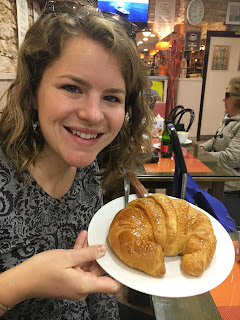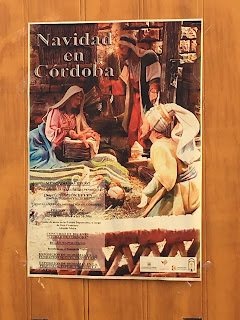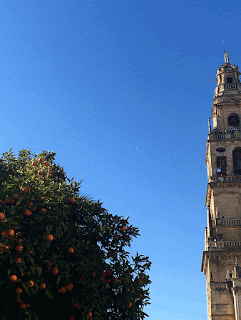Lydia wrote this post and my hilarious yet informative quips will appear in [brackets].
I read that the Mezquita, Córdoba’s main attraction, is free every morning from 8:30 - 9:30. Sounded like easy way to save $20, so we hurried over. Unfortunately, when we arrived, at 9:27, we were already too late. We were so annoyed at this ridiculousness that we decided to forgo the Mezquita altogether. We did snap a few pictures of the outside though.
We had some time to kill before our free walking tour, so we stopped for breakfast at a little café. John ordered what we assumed was a sandwich, but all the parts came separately. He got a plate of ham, two small bowls of mashed tomatoes, a bottle of olive oil, and two pieces of toasted baguette. It was pretty amusing. I ordered a croissant that ended up being as big as my head.
We met our tour guide at Plaza de las Tendillas. I was excited because her name was Lidia, and she’s a teacher too! Crazy I know.
Following a brief history of the city, we stopped to look at a Roman temple that looked very similar to the one we saw yesterday in Evora.
Next we walked to the Plaza de la Corredera. According to Lidia, this style of square, which looks similar to the one in Salamanca, is an unusual sight in southern Spain. It was once the place to see bullfights.
We rounded the corner and ended in Plaza del Porto, once a bustling livestock market. Today it’s most well known for its reference in Don Quixote, and for being the birthplace of the Spanish artist Julio Remero de Torres who painted Oranges and Lemons.
We eventually found ourselves back at the Mezquita. Lidia told us a bit more about its history. The mosque was built in 785 by Emir Abd-ar-Rahman I on the site of the Christian Visigothic church of St. Vincent. It was enlarged several times throughout the years by a series of Arab rulers. In 1236, after Córdoba was recaptured by Ferdinand III of Castile, the mosque was converted into a Christian church. Later a cathedral building was added to the center of the mosque. Even today there’s controversy over the building. Muslims have formally requested the right to pray in the building, but the request has been denied by the Vatican.
As we continued our tour, we passed the Alcázar de los Reyes Cristianos. This is where Christopher Columbus first met Fernando and Isabel. Lidia said the inside is prettier than the outside, and we’ll just have to take her word for it because we never ventured in.
During the last part of the tour we walked through the old Jewish neighborhood. We passed the synagogue, one of only three remaining medieval synagogues in Spain, and a statue of Maimonides, a well-known Jewish philosopher and physician born in Córdoba. According to Lidia, Maimonides was one of the first physicians to advocate for preventative medicine.
After the tour, we had to deal with the rental car company. Luckily, there was a Europcar branch at the train station. Not as lucky, there weren’t any automatic cars available in Córdoba. We had to settle for a manual that we would later trade in for an automatic in Sevilla. After picking up our bags from the Airbnb, I drove us out of town, and about an hour or so later we landed at the Sevilla train station. We did some explaining and some luggage rearranging, and we finally had a car again!
Once that was settled, we headed for Sevilla’s Alcázar. I’ve been to Sevilla once before and remember this as the highlight of my trip, so I was pretty excited to show John. When we finally arrived, it was only an hour before closing, and there was a line out the door. Fortunately it moved quickly, and we eventually made it inside. We were a bit rushed, but I think we saw it all. Similar to many things we’ve seen this week, the palace has Moorish influences and has been expanded several times throughout the years as it’s been passed back and forth between Christians and Muslims.
After our quick visit to the Alcazar, we strolled through the town and had tapas amongst the locals at Bar Alfalfa.
We ended the night by driving a bit farther south to our hotel in Jerez.
I read that the Mezquita, Córdoba’s main attraction, is free every morning from 8:30 - 9:30. Sounded like easy way to save $20, so we hurried over. Unfortunately, when we arrived, at 9:27, we were already too late. We were so annoyed at this ridiculousness that we decided to forgo the Mezquita altogether. We did snap a few pictures of the outside though.
[Santa has an elegant magical way of getting into your house to put presents under the tree. The three wisemen are apparently much more like cat burglars.]
[I loved the way Lidia talked. She had a good sized accent on her to start with: she'd had that lispy Spanish thing going on and would say "thentury" instead of century and "litheral" instead of literal. She referred to the tour group as "my family" and would say hilarious things like "now let's go to this part of town, you are so brave my family."]
[Lidia said that this hole would have been filled with sand as an earthquake damage prevention measure. I'm really wondering if this actually worked.]
We rounded the corner and ended in Plaza del Porto, once a bustling livestock market. Today it’s most well known for its reference in Don Quixote, and for being the birthplace of the Spanish artist Julio Remero de Torres who painted Oranges and Lemons.
We eventually found ourselves back at the Mezquita. Lidia told us a bit more about its history. The mosque was built in 785 by Emir Abd-ar-Rahman I on the site of the Christian Visigothic church of St. Vincent. It was enlarged several times throughout the years by a series of Arab rulers. In 1236, after Córdoba was recaptured by Ferdinand III of Castile, the mosque was converted into a Christian church. Later a cathedral building was added to the center of the mosque. Even today there’s controversy over the building. Muslims have formally requested the right to pray in the building, but the request has been denied by the Vatican.
As we continued our tour, we passed the Alcázar de los Reyes Cristianos. This is where Christopher Columbus first met Fernando and Isabel. Lidia said the inside is prettier than the outside, and we’ll just have to take her word for it because we never ventured in.
[There have been orange trees everywhere so I finally asked Lidia what the deal was and if people ever ate them. She said that they are like a wild variety that is so bitter that they don't taste good. But twice a year the government collects them all and makes marmalade that they then sell to help with the cost of upkeep.]
[Miraculously we haven't had to pay to use the bathroom anywhere so far.]
[We popped into this leather shop in order to see the building's interior.]
Once that was settled, we headed for Sevilla’s Alcázar. I’ve been to Sevilla once before and remember this as the highlight of my trip, so I was pretty excited to show John. When we finally arrived, it was only an hour before closing, and there was a line out the door. Fortunately it moved quickly, and we eventually made it inside. We were a bit rushed, but I think we saw it all. Similar to many things we’ve seen this week, the palace has Moorish influences and has been expanded several times throughout the years as it’s been passed back and forth between Christians and Muslims.
After our quick visit to the Alcazar, we strolled through the town and had tapas amongst the locals at Bar Alfalfa.
[I still hate roundabouts but they do serve as a good place to put garish statues.]





























































No comments:
Post a Comment